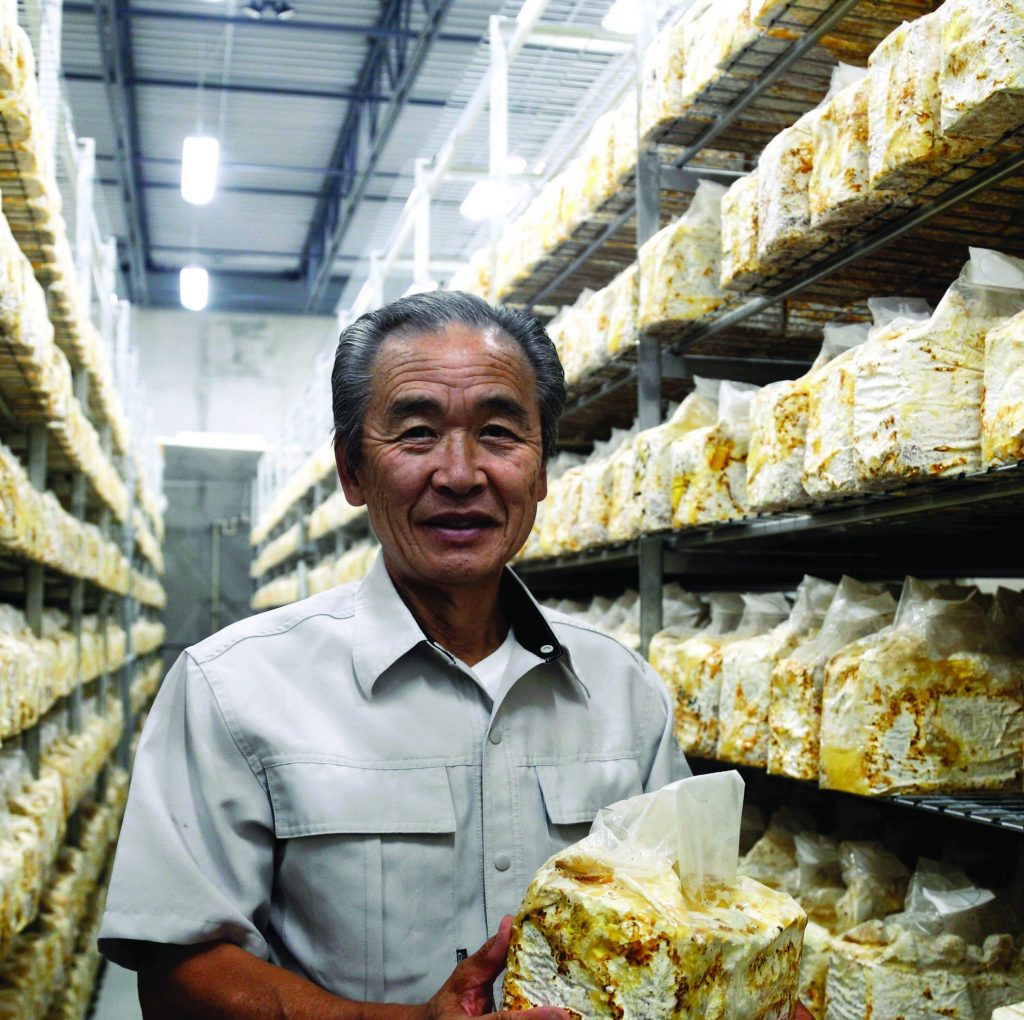Growing Ways
More sci-fi laboratory than greenhouse, Shogun Maitake employs
proprietary technology to cultivate a speciality mushroom
Photo: Yoshinobu Odaira, founder and CEO of Shogun Maitake Co. Ltd.
YOSHINOBU ODAIRA BRINGS a maitake mushroom to his face, closes his eyes, takes a deep breath and smiles. The scent from the grey-white curled caps and milky white stalk remind him of deep forests in the northeast mountains of his native Japan, where the mushrooms grow in clusters at the base of mature oak and beech trees.
Far from his homeland today, Odaira is the CEO of Shogun Maitake Co. Ltd., located on Colonel Talbot Road. The business grows maitake mushrooms in a 14,000-square-foot artificial environment using proprietary technology Odaira developed and refined over 35 years spent in the mushroom cultivation business in Japan.
Also known as hen-of-the-woods, ram’s head or the signorina mushroom, maitake mushrooms are praised for their rich, woodsy flavour, texture and purported medicinal properties (the maitake has been studied for years by mycologists and pharmacologists for its positive effects on tumours, hypertension, diabetes and obesity).
“Its medicinal value is well known around the world,” says Odaira, speaking through translator and Shogun Maitake executive assistant, Norimi Sakamoto.
Simulating the natural growing conditions in which maitake mushrooms thrive, the 10-employee operation began cultivation this past February, producing its first harvest in May. Outfitted to produce varying light, warmth, coolness, humidity and even wind, the facility grows maitake mushrooms that are comparable in fragrance, taste, texture and moisture content to those that grow in nature. Maturing in 90 days, the mushrooms are monitored 24 hours a day, and the entire production is done without pesticides, chemical fertilizers or additives.
The company is currently producing 400 pounds of mushrooms a week, and Odaira says production will soon ramp up to 1,200 pounds weekly (the average weight of a maitake mushroom grown at Shogun Maitake is 1.5 pounds). His long-term vision is to expand the operation to more than 400,000 square feet, with distribution to wholesalers and retailers across Canada and the Northeastern United States. Odaira anticipates annual revenue of between $2 and $3 million annually for the current operation, with the potential of eventually reaching $100 million with a larger facility.
The idea to establish Shogun Maitake in London dates back to 2013 when Odaira met with then-mayor Joe Fontana and representatives of the London Economic Development Corporation (LEDC), who were on a trade mission to Japan to sell the benefits of locating in London. At the time, Odaira owned a mushroom and vegetable production firm, the Yukiguni Company, which had annual sales of (Cdn) $318 million. He sold the company in 2014 in anticipation of starting the new business.
In late 2015, Odaira began working with the LEDC to find a suitable location to build the facility. The location in the city’s southwest is ideal because it allows for delivery of the mushrooms to key points in the Ontario and Northeastern U.S. markets in under 10 hours, which is the maximum delivery window to ensure the mushrooms remain at peak freshness.
Odaira credits the LEDC for support in helping to locate and launch the operation. “They were instrumental in making the facility succeed,” he says.
Since commencing operations, Shogun Maitake has initiated relationships with a number of wholesalers and retailers, including Sobey’s, Loblaws, United Grocers, Fresh Start, Remark Fresh Markets and Capo Food Ltd. The company has also been contacted by Food Network Canada, which is interested in incorporating maitake mushroom recipes into its programming and online content.
Local chef Scott Wesseling of Black Trumpet Restaurant on Richmond Row praises the maitake mushroom for its “distinctive flavour profile and its nutritional and health benefits.” The mushroom is known for accentuating the taste of other foods while being suitable for grilling, sautéing, stewing, stuffing or as a tempura.
“Previously, maitake were difficult to obtain,” says Wesseling. “They’re now readily available and locally produced. It’s a beautiful product.” ![]() Christine Dirks
Christine Dirks

